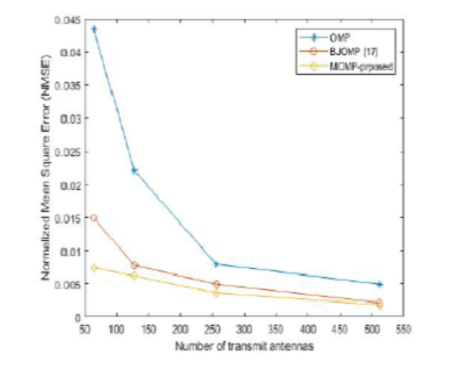


Indian Journal of Science and Technology
DOI: 10.17485/IJST/v14i33.1442
Year: 2021, Volume: 14, Issue: 33, Pages: 2663-2670
Original Article
Jagadeesh Chandra Prasad Matta1*, P Siddiah2
1Research Scholar, ECE Department University College of Engineering & Technology, Acarya Nagarjuna University, Guntur, Andhra Pradesh, India
2Professor in ECE Department, University College of Engineering & Technology, Acarya
Nagarjuna University, Guntur, Andhra Pradesh, India
*Corresponding Author
Email: [email protected]
Received Date:03 August 2021, Accepted Date:18 September 2021, Published Date:11 October 2021
Objectives: Massive Multiple-Input and Multiple-Output (MIMO) is the optimum way to enhance the bandwidth issue, in which the feedback overhead is a challenging concern when tested with Frequency Division Duplex (FDD) systems. Conventional greedy search algorithms like Matching Pursuit (MP) and Orthogonal Matching Pursuit (OMP) are based on the prior knowledge of the signal sparsity, which enhances overhead. So, the objective of this study is to develop a method with low complexity channel estimation and reduced feedback overhead. Methods: The proposed method is based on the residual vector which is updated after iteration and a threshold-based approach is utilized to decide the stopping criteria thereby controlling the number of iterations. The evaluation parameters used in the experimental analysis are Normalized Mean Square Error and channel capacity. Findings: The proposed method improves the effectiveness in signal recovery and reconstruction along with signal sparsity it also reduces the complexity of the estimation process and limits the feedback. This results in a high data rate and can be used in a massive MIMO system to optimize the channel estimation. Novelty : The proposed model is independent of the sparsity in the input vector and improves the effectiveness of the signal recovery and reduces the feedback burden. The proposed method is suitable for a 5G massive MIMO systems.
Keywords: Feedback overhead; CSI; OMP; Residue vector
© 2021 Matta & Siddiah. This is an open-access article distributed under the terms of the Creative Commons Attribution License, which permits unrestricted use, distribution, and reproduction in any medium, provided the original author and source are credited. Published By Indian Society for Education and Environment (iSee)
Subscribe now for latest articles and news.